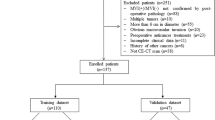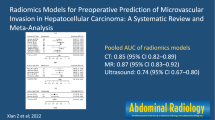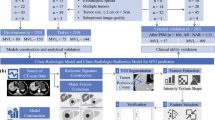Abstract
Objectives
To measure the performance and variability of a radiomics-based model for the prediction of microvascular invasion (MVI) and survival in patients with resected hepatocellular carcinoma (HCC), simulating its sequential development and application.
Methods
This study included 230 patients with 242 surgically resected HCCs who underwent preoperative CT, of which 73/230 (31.7%) were scanned in external centres. The study cohort was split into training set (158 patients, 165 HCCs) and held-out test set (72 patients, 77 HCCs), stratified by random partitioning, which was repeated 100 times, and by a temporal partitioning to simulate the sequential development and clinical use of the radiomics model. A machine learning model for the prediction of MVI was developed with least absolute shrinkage and selection operator (LASSO). The concordance index (C-index) was used to assess the value to predict the recurrence-free (RFS) and overall survivals (OS).
Results
In the 100-repetition random partitioning cohorts, the radiomics model demonstrated a mean AUC of 0.54 (range 0.44–0.68) for the prediction of MVI, mean C-index of 0.59 (range 0.44–0.73) for RFS, and 0.65 (range 0.46–0.86) for OS in the held-out test set. In the temporal partitioning cohort, the radiomics model yielded an AUC of 0.50 for the prediction of MVI, a C-index of 0.61 for RFS, and 0.61 for OS, in the held-out test set.
Conclusions
The radiomics models had a poor performance for the prediction of MVI with a large variability in the model performance depending on the random partitioning. Radiomics models demonstrated good performance in the prediction of patient outcomes.
Clinical relevance statement
Patient selection within the training set strongly influenced the performance of the radiomics models for predicting microvascular invasion; therefore, a random approach to partitioning a retrospective cohort into a training set and a held-out set seems inappropriate.
Key Points
• The performance of the radiomics models for the prediction of microvascular invasion and survival widely ranged (AUC range 0.44–0.68) in the randomly partitioned cohorts.
• The radiomics model for the prediction of microvascular invasion was unsatisfying when trying to simulate its sequential development and clinical use in a temporal partitioned cohort imaged with a variety of CT scanners.
• The performance of the radiomics models for the prediction of survival was good with similar performances in the 100-repetition random partitioning and temporal partitioning cohorts.





Similar content being viewed by others
Abbreviations
- CT:
-
Computed tomography
- HCC:
-
Hepatocellular carcinoma
- MRI:
-
Magnetic resonance imaging
- MVI:
-
Microvascular invasion
- OS:
-
Overall survival
- RFS:
-
Recurrence-free survival
References
European Association for the Study of the Liver (2018) EASL Clinical Practice Guidelines: management of hepatocellular carcinoma. J Hepatol 69:182-236. https://doi.org/10.1016/j.jhep.2018.03.019
Chen ZH, Zhang XP, Wang H et al (2019) Effect of microvascular invasion on the postoperative long-term prognosis of solitary small HCC: a systematic review and meta-analysis. HPB (Oxford) 21:935–944. https://doi.org/10.1016/j.hpb.2019.02.003
Roberts LR, Sirlin CB, Zaiem F et al (2018) Imaging for the diagnosis of hepatocellular carcinoma: a systematic review and meta-analysis. Hepatology 67:401–421. https://doi.org/10.1002/hep.29487
Min JH, Lee MW, Park HS et al (2020) Interobserver variability and diagnostic performance of gadoxetic acid-enhanced MRI for predicting microvascular invasion in hepatocellular carcinoma. Radiology 297:573–581. https://doi.org/10.1148/radiol.2020201940
Wei H, Jiang H, Liu X et al (2020) Can LI-RADS imaging features at gadoxetic acid-enhanced MRI predict aggressive features on pathology of single hepatocellular carcinoma? Eur J Radiol 132:109312. https://doi.org/10.1016/j.ejrad.2020.109312
Gillies RJ, Kinahan PE, Hricak H (2016) Radiomics: images are more than pictures, they are data. Radiology 278:563–577. https://doi.org/10.1148/radiol.2015151169
Peng J, Zhang J, Zhang Q, Xu Y, Zhou J, Liu L (2018) A radiomics nomogram for preoperative prediction of microvascular invasion risk in hepatitis B virus-related hepatocellular carcinoma. Diagn Interv Radiol 24:121–127. https://doi.org/10.5152/dir.2018.17467
Zheng BH, Liu LZ, Zhang ZZ et al (2018) Radiomics score: a potential prognostic imaging feature for postoperative survival of solitary HCC patients. BMC Cancer 18:1148. https://doi.org/10.1186/s12885-018-5024-z
Ahn SJ, Kim JH, Park SJ, Kim ST, Han JK (2019) Hepatocellular carcinoma: preoperative gadoxetic acid-enhanced MR imaging can predict early recurrence after curative resection using image features and texture analysis. Abdom Radiol (NY) 44:539–548. https://doi.org/10.1007/s00261-018-1768-9
Feng ST, Jia Y, Liao B et al (2019) Preoperative prediction of microvascular invasion in hepatocellular cancer: a radiomics model using Gd-EOB-DTPA-enhanced MRI. Eur Radiol 29:4648–4659. https://doi.org/10.1007/s00330-018-5935-8
Xu X, Zhang HL, Liu QP et al (2019) Radiomic analysis of contrast-enhanced CT predicts microvascular invasion and outcome in hepatocellular carcinoma. J Hepatol 70:1133–1144. https://doi.org/10.1016/j.jhep.2019.02.023
Liu Q, Li J, Liu F et al (2020) A radiomics nomogram for the prediction of overall survival in patients with hepatocellular carcinoma after hepatectomy. Cancer Imaging 20:82. https://doi.org/10.1186/s40644-020-00360-9
Wilson GC, Cannella R, Fiorentini G et al (2020) Texture analysis on preoperative contrast-enhanced magnetic resonance imaging identifies microvascular invasion in hepatocellular carcinoma. HPB (Oxford) 22:1622–1630. https://doi.org/10.1016/j.hpb.2020.03.001
Chen Y, Xia Y, Tolat PP et al (2021) Comparison of conventional gadoxetate disodium-enhanced MRI features and radiomics signatures with machine learning for diagnosing microvascular invasion. AJR Am J Roentgenol 216:1510–1520. https://doi.org/10.2214/AJR.20.23255
Chong HH, Yang L, Sheng RF et al (2021) Multi-scale and multi-parametric radiomics of gadoxetate disodium-enhanced MRI predicts microvascular invasion and outcome in patients with solitary hepatocellular carcinoma ≤ 5 cm. Eur Radiol 31:4824–4838. https://doi.org/10.1007/s00330-020-07601-2
Liu SC, Lai J, Huang JY et al (2021) Predicting microvascular invasion in hepatocellular carcinoma: a deep learning model validated across hospitals. Cancer Imaging 21:56. https://doi.org/10.1186/s40644-021-00425-3
Wang Q, Li C, Zhang J et al (2021) Radiomics models for predicting microvascular invasion in hepatocellular carcinoma: a systematic review and radiomics quality score assessment. Cancers (Basel) 13:5864. https://doi.org/10.3390/cancers13225864
Edmondson HA, Steiner PE (1954) Primary carcinoma of the liver: a study of 100 cases among 48,900 necropsies. Cancer 7:462–503. https://doi.org/10.1002/1097-0142(195405)7:3%3c462::aid-cncr2820070308%3e3.0.co;2-e
WHO Classification of Tumours (2019) Digestive system tumours, 5th edition. IARC, Lyon, France, pp 229–239
Bedossa P, Poynard T (1996) An algorithm for the grading of activity in chronic hepatitis C. The METAVIR Cooperative Study Group. Hepatology 24:289-293. https://doi.org/10.1002/hep.510240201
Kleiner DE, Brunt EM, Van Natta M et al (2005) Design and validation of a histological scoring system for nonalcoholic fatty liver disease. Hepatology 41:1313–1321. https://doi.org/10.1002/hep.20701
MedSeg—Free Medical Segmentation Online. Available online: https://www.medseg.ai/. Accessed June 2022
Zhang Z, Chen J, Jiang H et al (2020) Gadoxetic acid-enhanced MRI radiomics signature: prediction of clinical outcome in hepatocellular carcinoma after surgical resection. Ann Transl Med 8:870. https://doi.org/10.21037/atm-20-3041
van Griethuysen JJM, Fedorov A, Parmar C et al (2017) Computational radiomics system to decode the radiographic phenotype. Cancer Res 77:e104–e107. https://doi.org/10.1158/0008-5472.CAN-17-0339
Radiomics/pyradiomics Available online: https://github.com/Radiomics/pyradiomics. Accessed March 2022
Zwanenburg A, Leger S, Vallières M et al (2020) Image biomarker standardisation initiative. Radiology 295:328–338. https://doi.org/10.1148/radiol.2020191145
Leijenaar RT, Nalbantov G, Carvalho S et al (2015) The effect of SUV discretization in quantitative FDG-PET radiomics: the need for standardized methodology in tumor texture analysis. Sci Rep 5:11075. https://doi.org/10.1038/srep11075
Van Rossum G, Drake Jr FL (1995) Python reference manual. Centrum voor Wiskunde en Informatica Amsterdam
Pedregosa F, Varoquaux G, Gramfort A et al (2011) Scikit-learn: machine learning in Python. J Mach Learn Res 12:2825–2830
Pölsterl S (2020) scikit-survival: a library for time-to-event analysis built on top of scikit-learn. J Mach Learn Res 21:1–6
Zhong X, Long H, Su L et al (2022) Radiomics models for preoperative prediction of microvascular invasion in hepatocellular carcinoma: a systematic review and meta-analysis. Abdom Radiol (NY) 47:2071–2088. https://doi.org/10.1007/s00261-022-03496-3
Berenguer R, Pastor-Juan MDR, Canales-Vázquez J et al (2018) Radiomics of CT features may be nonreproducible and redundant: influence of CT acquisition parameters. Radiology 288:407–415. https://doi.org/10.1148/radiol.2018172361
Meyer M, Ronald J, Vernuccio F et al (2019) Reproducibility of CT radiomic features within the same patient: influence of radiation dose and CT reconstruction settings. Radiology 293:583–591. https://doi.org/10.1148/radiol.2019190928
Xu Y, Lu L, Sun SH et al (2022) Effect of CT image acquisition parameters on diagnostic performance of radiomics in predicting malignancy of pulmonary nodules of different sizes. Eur Radiol 32:1517–1527. https://doi.org/10.1007/s00330-021-08274-1
Healy GM, Salinas-Miranda E, Jain R et al (2022) Preoperative radiomics model for prognostication in resectable pancreatic adenocarcinoma with external validation. Eur Radiol 32:2492–2505. https://doi.org/10.1007/s00330-021-08314-w
Zhang Z, Jiang H, Chen J et al (2019) Hepatocellular carcinoma: radiomics nomogram on gadoxetic acid-enhanced MR imaging for early postoperative recurrence prediction. Cancer Imaging 19:22. https://doi.org/10.1186/s40644-019-0209-5
Ünal E, İdilman İS, Akata D et al (2016) Microvascular invasion in hepatocellular carcinoma. Diagn Interv Radiol 22:125–132. https://doi.org/10.5152/dir.2015.15125
Funding
The authors state that this work has not received any funding.
Author information
Authors and Affiliations
Corresponding author
Ethics declarations
Guarantor
The scientific guarantor of this publication is Marco Dioguardi Burgio.
Conflict of interest
Maxime Ronot is a member of the European Radiology Editorial Board. They have not taken part in the review or selection process of this article.
The authors of this manuscript declare no relationships with any companies, whose products or services may be related to the subject matter of the article.
Statistics and biometry
One of the authors has significant statistical expertise.
Informed consent
Written informed consent was waived by the Institutional Review Board.
Ethical approval
Institutional Review Board approval was obtained.
Study subjects or cohorts overlap
Some study subjects or cohorts have been previously reported in the following publication: https://doi.org/10.1016/j.jhepr.2021.100380. In this previous study, the aim was to report Liver Imaging Reporting and Data System (LI-RADS)–defined imaging features of different HCC subtypes.
Methodology
• retrospective
• diagnostic or prognostic study
• performed at one institution
Additional information
Publisher's note
Springer Nature remains neutral with regard to jurisdictional claims in published maps and institutional affiliations.
Supplementary Information
Below is the link to the electronic supplementary material.
Rights and permissions
Springer Nature or its licensor (e.g. a society or other partner) holds exclusive rights to this article under a publishing agreement with the author(s) or other rightsholder(s); author self-archiving of the accepted manuscript version of this article is solely governed by the terms of such publishing agreement and applicable law.
About this article
Cite this article
Cannella, R., Santinha, J., Bèaufrere, A. et al. Performances and variability of CT radiomics for the prediction of microvascular invasion and survival in patients with HCC: a matter of chance or standardisation?. Eur Radiol 33, 7618–7628 (2023). https://doi.org/10.1007/s00330-023-09852-1
Received:
Revised:
Accepted:
Published:
Issue Date:
DOI: https://doi.org/10.1007/s00330-023-09852-1




